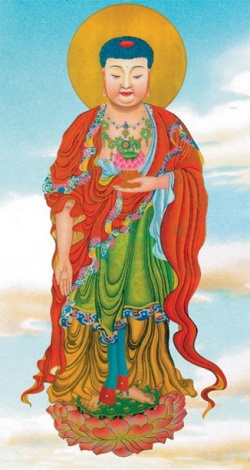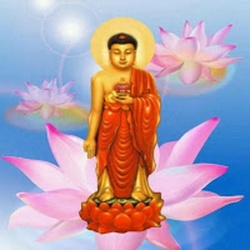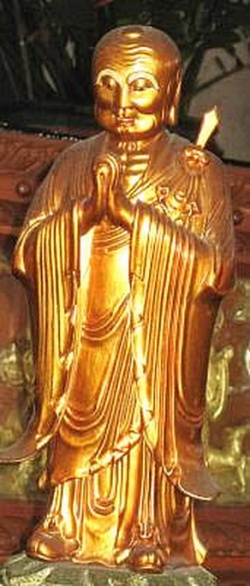Buddhahood
The state of awakening that a Buddha has attained. The ultimate goal of Buddhist practice and the highest of the Ten Worlds. The word enlightenment is often used synonymously with Buddhahood. Buddhahood is regarded as a state of perfect freedom, in which one is awakened to the eternal and ultimate truth that is the reality of all things. This supreme state of life is characterized by boundless wisdom and infinite compassion. The Lotus Sutra reveals that Buddhahood is a potential in the lives of all beings.
See also; attainment of Buddhahood
Buddhahood (Wyl. sangs rgyas kyi go 'phang) is also called "state of enlightenment" or simply "enlightenment". It is the ultimate goal of the Buddhist path attained when we become a buddha.
In Buddhism, buddhahood (Sanskrit: बुद्धत्व buddhatva; Pali: बुद्धत्त buddhatta or बुद्धभाव buddhabhāva) is the state of perfect enlightenment (Sanskrit: सम्यक्सम्बोधि samyaksambodhi; Pali: सम्मासम्बोधि sammāsambodhi) attained by a buddha (/ˈbuːdə/ or /ˈbʊdə/; Sanskrit pronunciation: [ˈbud̪d̪ʱə]; Pali/Sanskrit for "awakened one").
Buddhahood (sangs rgyas). The perfect and complete enlightenment dwelling in neither samsara nor nirvana; the state of having eradicated all obscurations, endowed with the wisdom of seeing the nature of things as it is and with the wisdom of perceiving all that exists.
Explanation of the term Buddha
In Theravada Buddhism, Buddha refers to one who has become enlightened through his own efforts and insight, without a teacher to point out the Dharma. A samyak sambuddha teaches the dhamma to others after his awakening. A pratyeka-buddha also reaches Nirvana through his own
efforts, but does not teach the dhamma to others. An Arhat needs to follow the teaching of a Buddha to attain Nirvana, but can also preach the dhamma after attaining Nirvana In one instance the term buddha is also used in Theravada to refer to all who attain Nirvana, using the term Sāvakabuddha to designate an Arhat, someone who depends on the teachings of a Buddha to attain Nirvana.
There is a broad spectrum of opinion on the universality and method of attainment of Buddhahood, depending on the Shakyamuni Buddha's teachings that a school of Buddhism emphasizes. The level to which this manifestation requires (ascetic practices) varies from none at all to an absolute requirement, dependent on doctrine. Mahayana Buddhism emphasizes the Bodhisattva ideal instead of the Arhat.
The Tathagatagarba and Buddha-nature doctrines of Mahayana Buddhist consider Buddhahood to be a universal and innate property of absolute wisdom. This wisdom is revealed in a person's current lifetime through Buddhist practice, without any specific relinquishment of pleasures or "earthly desires".
Buddhists do not consider Siddhartha Gautama to have been the only Buddha. The Pali Canon refers to many previous ones (see List of the 28 Buddhas), while the Mahayana tradition additionally has many Buddhas of celestial, rather than historical, origin (see Amitabha or Vairocana as examples, for lists of many thousands Buddha names see Taishō Shinshū Daizōkyō numbers 439–448). A common Theravada and Mahayana Buddhist belief is that the next Buddha will be one named Maitreya (Pali: Metteyya).
Nature of the Buddha
The various Buddhist schools hold some varying interpretations on the :nature of Buddha (see below).
Spiritual realizations
All Buddhist traditions hold that a Buddha is fully awakened and has completely purified his mind of the three poisons of desire, aversion and ignorance. A Buddha is no longer bound by Samsara, and has ended the suffering which unawakened people experience in life.
Most schools of Buddhism have also held that the Buddha was omniscient. However, the early texts contain explicit repudiations of making this claim of the Buddha.
Ten characteristics of a Buddha
Some Buddhists meditate on (or contemplate) the Buddha as having ten characteristics (Ch./Jp. 十號). These characteristics are frequently mentioned in the Pali Canon as well as Mahayana teachings, and are chanted daily in many Buddhist monasteries:
- Tathāgata thus gone, thus come (Skt: Tathāgata)
- Arhat|worthy one (Skt: arhat)
- perfectly self-enlightened (Skt: samyak-saṃbuddha)
- perfected in knowledge and conduct (Skt: vidyā-caraṇa-saṃpanna )
- well gone (Skt: sugata)
- unsurpassed (Skt: anuttara)
- knower of the world (Skt: loka-vid)
- leader of persons to be tamed (Skt: puruṣa-damya-sārathi)
- teacher of the gods and humans (Skt: śāsta deva-manuṣyāṇaṃ)
- the Blessed One or fortunate one (Skt: bhagavat)
The tenth epithet is sometimes listed as "The World Honored Enlightened One" (Skt. Buddha-Lokanatha) or "TheBlessed Enlightened One" (Skt. Buddha-Bhagavan).
Buddha as a supreme human
Although the Theravada school does not emphasize the more supernatural and divine aspects of the Buddha that are available in the Pali Canon, elements of Buddha as the supreme person are found throughout this canon.
In the Pali Canon Gautama Buddha is known as being a "teacher of the gods and humans", superior to both the gods and humans in the sense of having nirvana or the greatest bliss, whereas the devas or gods of are still subject to anger, fear and sorrow.
In the Madhupindika Sutta (MN 18), Buddha is described in powerful terms as the Lord of the Dhamma (Pali: Dhammasami, skt.: Dharma Swami) and the bestower of immortality (Pali: Amatassadata).
Similarly, in the Anuradha Sutta (SN 44.2) Buddha is described as
- the Tathagata—the supreme man, the superlative man, attainer of the superlative attainment.
- (Buddha is asked about what happens to the Tathagatha after death of the physical body. Buddha replies],
- "And so, Anuradha—when you can't pin down the Tathagata as a truth or reality even in the present life—is it proper for you to declare, 'Friends, the Tathagata—the supreme man, the superlative man, attainer of the superlative attainment—being described, is described otherwise than with these four positions: The Tathagata exists after death, does not exist after death, both does & does not exist after death, neither exists nor does not exist after death'?
In the Vakkali Sutta (SN 22.87)Buddha identifies himself with the Dhamma:
Another reference from the Aggañña Sutta of the Digha Nikaya, says to his disciple Vasettha:
- O Vasettha! The Word of Dhammakaya is indeed the name of the Tathagata
Buddha as "just a human"
Within Theravada Buddhism emerges the view that the Buddha was human, endowed with the greatest psychic powers (Kevatta Sutta). The body and mind (the five khandhas) of a Buddha are impermanent and changing, just like the body and mind of ordinary people. However, a Buddha recognizes the unchanging nature of the Dharma, which is an eternal principle and an unconditioned and timeless phenomenon. This view is common in the Theravada school, and the other early Buddhist schools.
Statements from modern Theravadins that the Buddha was "just a human" are often intended to contrast their view of him with that of the Mahayana, and with Christian views of Jesus. According to the Canon, Gotama was born as a human, albeit highly spiritually developed as a result of the previous lives in the career of the Bodhisatta. With his Enlightenment, however, he perfected and transcended his human condition.
When asked whether he was a deva or a human, he replied that he had eliminated the deep-rooted unconscious traits that would make him either one, and should instead be called a Buddha; one who had grown up in the world but had now gone beyond it, as a lotus grows from the water but blossoms above it, unsoiled.
Eternal Buddha in Mahayana Buddhism
In the Dharmakaya doctrine the Buddha teaches that the Buddha is no longer essentially a human being, but has become a being of a different order altogether. In his ultimate transcendental "body/mind" mode as Dharmakaya, he has eternal and infinite life, is present in all things as the Buddha-nature, and is possessed of great and immeasurable qualities.
The Nirvana Sutra mentions the Buddha-nature as "the boundless Dharmadhatu". The Lotus Sutra and especially such tantras as the Kunjed Gyalpo Tantra give expression to a vision of the Buddha as the omnipresent, all-knowing, ppliberative essence)] and deathless Reality of all things.
In the Mahaparinirvana Sutra the Buddha declares:
- Nirvana is stated to be eternally abiding. The Tathagata (Buddha) is also thus, eternally abiding, without change.
This is a particularly important metaphysical and soteriological doctrine in the Lotus Sutra and the Tathagatagarbha Tathagatagarbha sutras. According to the Tathagatagarbha [[Tathagatagarbha] sutras]], failure to recognize the Buddha's eternity and, even worse, outright denial of that eternity, is deemed a major obstacle to the attainment of complete awakening (Bodhi).
For the Tibetan Buddhist master, Dolpopa, and his Jonangpa School, the Buddha is to be understood as the wondrous and holy wish-fulfilling Essence of all things, beyond comprehension:
- Buddha—an essence of immeasurable, incomprehensible, unfathomable, excellent exalted body, wisdom, qualities, and activities extremely wondrous and fantastic—is vast like space and the holy source, giving rise to all that is wished by sentient beings like a wish-granting jewel, a wish-granting tree …
The Buddha as compared to God
The commonly accepted definition of the term "God" is of a being who rules and created the universe. Buddhism offers an elaborate cosmology, including gods and Devas. But the Buddha of the early texts also gives arguments refuting the existence of such beings. These gods are not viewed as creators, they are subject to suffering and change like all other living beings, and must eventually die.
A common misconception among non-Buddhists is that the Buddha is the Buddhist counterpart to "God". Buddhism does not teach the dependency on any supreme being for enlightenment. The Buddha is a guide and teacher who points the way to enlightenment, but the struggle for enlightenment is one's own.
Types of Buddhahood
Samyaksambuddha
Samyaksam buddhas (Pali: sammasambuddha) gain Nirvana by their own efforts, and discover the Dhamma without having a teacher to point it out. They then lead others to enlightenment by teaching the Dhamma in a time or world where it has been forgotten or has not been taught before, because a Samyaksam buddha does not depend upon a tradition that stretches back to a previous Samyaksambuddha, but instead discovers the path anew. In the Bahudhātuka Sutta ("Many Kinds of Elements Discourse]]," MN 115), the Buddha tells Ven. Ānanda:
- It is impossible, it cannot happen that two Accomplished Ones, Fully Enlightened Ones, could arise contemporaneously in one world-system—there is no such possibility.
The historical Buddha, Gautama Buddha, is considered a Samyaksambuddha. See also the list of 28 sammasam Buddhas buddhas.
Three variations can be distinguished in the way of achieving Samyaksambuddha-hood. With more wisdom (prajñādhika), with more effort (vīryādhika) or with more faith (śraddhādhika). Śākyamuni was a Prajñādhika (through more wisdom) Buddha. The next Buddha of this world, Maitreya (Pāli: Metteyya) will be a Vīryādhika (through more effort) Buddha.
Pratyekabuddha
Pratyeka buddhasBuddhas (Pali: paccekabuddha) are similar to Samyaksam Buddhas in that they attain Nirvāṇa without having a teacher. Unlike the Samyaksambuddha however, they do not teach the Dhamma that they have discovered. Thus, they also do not form a Saṅgha of disciples to carry on the teaching, since they do not teach in the first place.
In some works they are referred to as "silent Buddhas". Several comparatively new Buddhist scriptures (of later origin; after the Buddha's demise, like the Jātakas), show Pratyeka buddhas giving teachings. A Paccekabuddha can sometimes teach and admonish people, but these admonitions are only in reference to good and proper conduct (Pali: abhisamācārikasikkhā), not concerning Nirvana.
In some texts, they are described as 'one who understands the Dharma by his own efforts, but does not obtain omniscience nor mastery over the Fruits' (phalesu vasībhāvam).
Relationship to arhatship
Śrāvaka (Skt.; Pali: sāvaka; means "hearer" or "follower") is a disciple of a Samyaksambuddha. An enlightened disciple is generally called an arahant (Noble One) or ariya-sāvaka (Noble Disciple). (These terms have slightly varied meanings but can both be used to describe the [[enlightened
disciple]].) The Theravadin commentary to the Udana uses the term sāvaka-buddha (Pali) to describe the enlightened disciple The term Savakabuddha does not occur in the Theravadin Pali Canon, but is mentioned in three Theravadin commentarial works, and refers to an enlightened disciple of the Buddha. The usual term is Arhat.
Enlightened disciples attain Nirvana as do the two aforementioned Types of Buddha's. After attaining Enlightenment, disciples may also lead others to Enlightenment. One can not become a disciple of a Buddha in a time or world where the teaching of the Buddha has been forgotten or has not been taught before, because this type of Enlightenment is dependent on a tradition that stretches back to a Samyaksambuddha.
A rarely used word, anubuddha, was a term used by the Buddha in the Khuddakapatha for those who become Buddhas after being given instruction.
Depictions of the Buddha in art

Buddhas are frequently represented in the form of statues and paintings. Commonly seen designs include:
- Hotei or Budai, the obese Laughing Buddha, usually seen in China (This figure is believed to be a representation of a medieval Chinese monk who is associated with Maitreya, the future Buddha, and is therefore technically not a Buddha image.)
- the Emaciated Buddha, which shows Siddhartha Gautama during his extreme ascetic practice of starvation.
The Buddha statue shown calling for rain is a pose common in Laos.
Markings
Most depictions of Buddha contain a certain number of markings, which are considered the signs of his Enlightenment. These signs vary regionally, but two are common:
- a protuberance on the top of the head (denoting superb mental acuity)
- long earlobes (denoting superb perception)
In the Pali Canon there is frequent mention of a list of 32 physical marks of Buddha.
Hand-gestures
The poses and hand-gestures of these statues, known respectively as asanas and mudras, are significant to their overall meaning. The popularity of any particular mudra or asana tends to be region-specific, such as the Vajra mudra (or Ch Ken-in) mudra, which is popular in Japan and Korea but rarely seen in India. Others are more common; for example, the Varada (Wish Granting) mudra is common among standing statues of the Buddha, particularly when coupled with the Abhaya (Fearlessness and Protection) mudra.
Names of the Buddha
Aśvaghoṣa in his Acts of the Buddha gives a long list of names for the Buddha:
- Buddha, Self-existent, Lord of Law (Dharmaraja), Nayaka, Vinayaka, Caravan Leader, Jina (Victorious One), the Master-giver of Dharma, The Teacher, Master of the Dharma, the Lord of the World, the consoler, the loving-regarder [cf. Avalokiteshvara, the Hero, the champion, the victorious one in conflict, Light of the World, Illuminator of the Knowledge of True Wisdom, The dispeller of the darkness of ignorance,
Illuminator of the Great Torch, [[Great Physician, Great Seer, the Healer, Attainer of the Great Vehicle (Mahayana), Lord of all Dharma, the Ruler, Monarch of All Worlds, the Sovereign, Lord of all wisdom, the wise, the destroyer of the pride of all disputers, the omniscient,
the Arhat, Possessor of Perfect Knowledge, the Great Buddha, Lord of Saints, The Victorious, the Perfect Buddha, Sugata, the wise one who fulfills the wishes of all beings, The ruler of the world, bearer of the world, master of the world, sovereign of the world, teacher of
the world, preceptor of the world, The Fount of Nectar, the powerful luminary, Bringer of all virtue and all real wealth, possessor of perfect excellence and all good qualities, the guide on the road of wisdom who shows the way to Nirvana, Tathagata without stain, without attachment, without uncertainty.
In his commentary to the Surangama Sutra, Venerable Master Hsuan Hua tells the following fable:
- Originally every Buddha had ten thousand names. In time these ten thousand names were reduced to one thousand because people got confused trying to remember them all. For a while every Buddha had a thousand names, but people still couldn’t remember so many, so they were again reduced to one hundred names. Every Buddha had a hundred different names and living beings had a hard time remembering them, so they were shortened again to ten.






